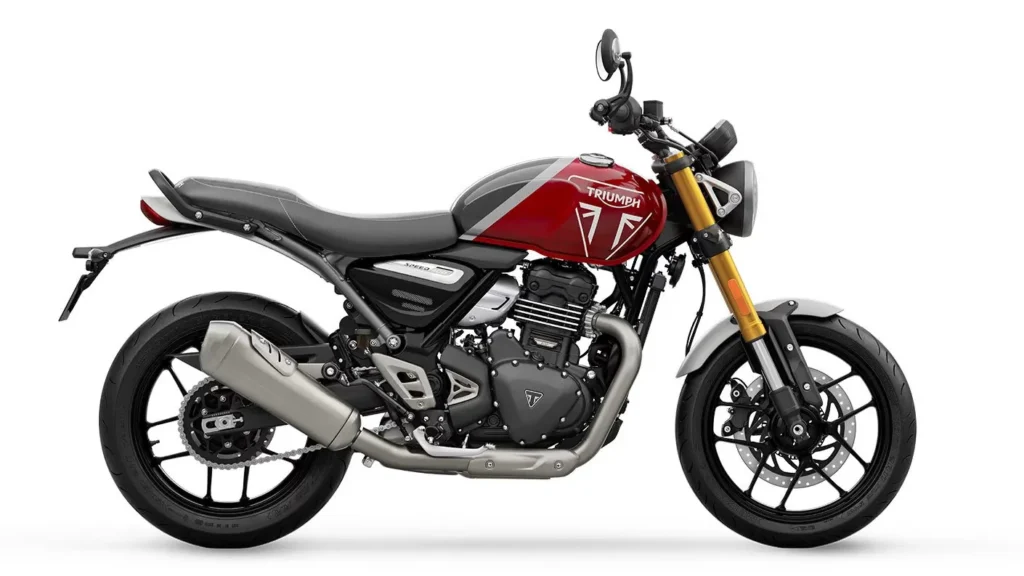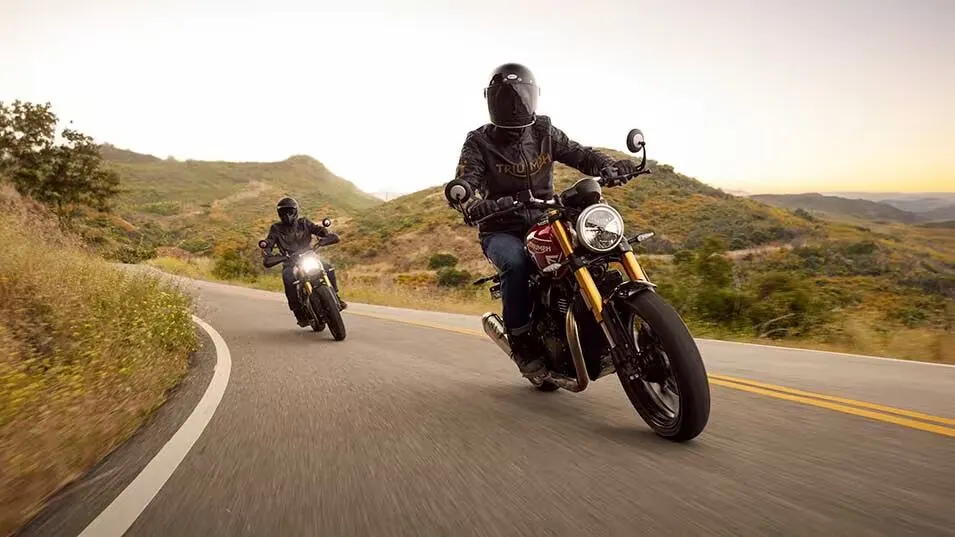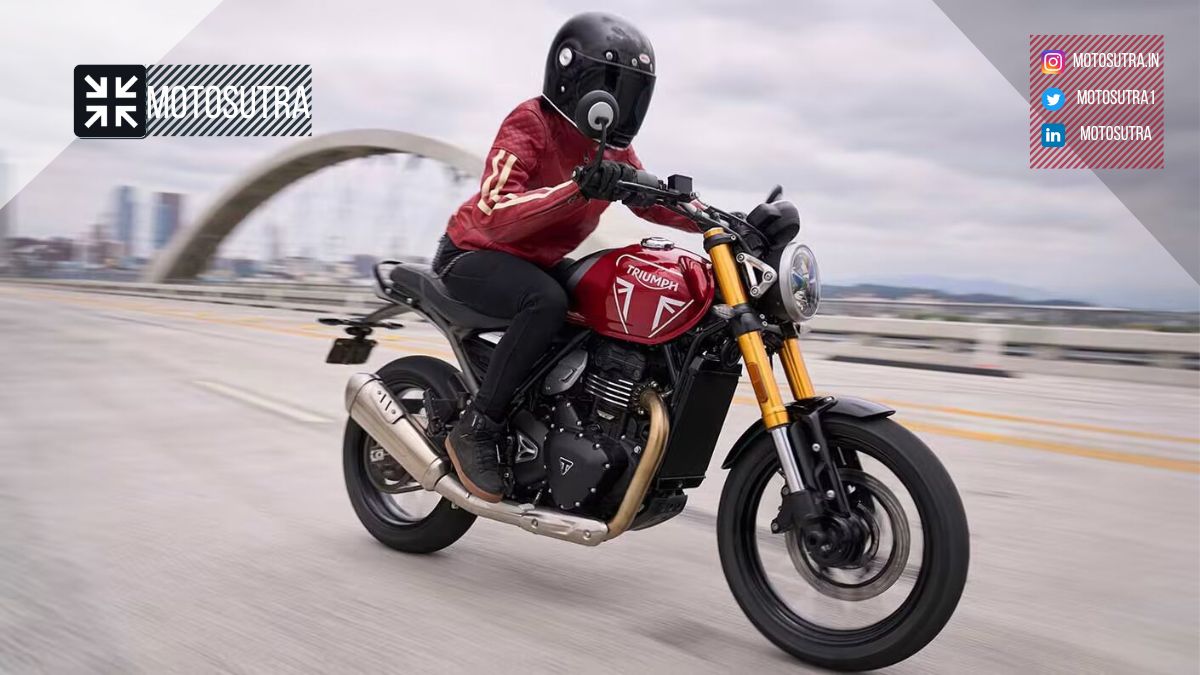The new Triumph Speed 400 is an exciting addition to Triumph’s modern classic range. Slotting in below the popular Street Twin 900, it aims to bring Triumph’s design, quality, and riding experience to a lower price point. In this review, we’ll take an in-depth look at what the Speed 400 is like to ride and own.
Overview of the Triumph Speed 400
The Speed 400 uses an all-new 399cc single-cylinder engine making 40 hp and 35 Nm. It’s built in collaboration with Indian giant Bajaj, who will also distribute and service the bikes in India. The focus is on delivering refined real-world performance rather than just big numbers on paper.
Visually, the bike stays true to Triumph’s signature style. The fit and finish are excellent with beautiful attention to detail. Switchable traction control, LED lighting, and dual-channel ABS add to the premium appeal.
Priced at just ₹2.34 lakh ex-showroom, the Speed 400 undercuts every other premium 400cc+ single-cylinder bike. It promises Triumph quality and character at an affordable price point. Let’s take a closer look to see if it delivers.

Design and Styling
Park the Speed 400 next to Triumph’s Street Twin 900 and the family resemblance is obvious. The shapes and silhouettes are beautifully integrated to create a cohesive design language. Details like the mirrors, engine cases, and exhaust enhance visual continuity with the larger bikes.
The Speed 400 looks handsome and modern while retaining that classic charm. Build quality is excellent with precise panel gaps and high-quality finishes. All cables and hoses are tucked away neatly. It’s a level above anything else at this price.
The minimal tail section and stubby exhaust suit the streetfighter styling. Some may find the bike’s proportions a bit small but it remains fairly comfortable for larger riders. Overall, the Speed 400 brings a tasteful, premium quality design that looks like a proper Triumph.
Riding Position and Ergonomics
The Speed 400 has a roadster riding position – sporty yet upright. The footpegs are set back moderately while the raised clip-on style bars keep the upper body vertical. It’s comfortable for longer rides without being overly committed.
At 790mm, the seat height is accessible for most riders. Taller folks have enough room too. Pillion comfort is reasonable with a wide, well-shaped seat and grab rails. The soft cushioning is great around town but some may want more support for highway stints. An accessory seat is available to address this.
Overall, the riding position balances comfort and sportiness nicely. It’s easy to maneuver in traffic without compromising longer distance capability.
Engine Performance
Power and Torque Delivery
The 399cc single-cylinder engine makes a modest 40 hp. However, a strong mid-range punch sets it apart from KTM and Bajaj singles. 80% of the 35 Nm torque peak is available from just 3,000 to 9,000 rpm resulting in effortless real-world performance.
The meaty mid-range gives it stronger acceleration than expected. It can get quite buzzy above 7,000 rpm but there’s no need to wring its neck to go fast. It’s much more refined if ridden smoothly.
| ENGINE & TRANSMISSION | |
| Type | Liquid-cooled, 4 valve, DOHC, single-cylinder |
| Capacity | 398.15 cc |
| Bore | 89.0 mm |
| Stroke | 64.0 mm |
| Compression | 12:1 |
| Max Power EC | 40 PS / 39.5 bhp (29.4 kW) @ 8,000 rpm |
| Max Torque EC | 37.5 Nm @ 6,500 rpm |
| System | Bosch electronic fuel injection with electronic throttle control |
| Exhaust | Stainless twin-skin header system with stainless steel silencer |
| Final Drive | X-ring chain |
| Clutch | Wet, multi-plate, slip |
| Gearbox | 6 speed |
Top Speed and Acceleration
We saw an indicated top speed of 170 kph with a realistic 150 kph flat out. 0-100 kph takes about 6 seconds. The strong mid-range means you can make quick overtakes and short bursts up to illegal speeds without revving it out.
While not as fast as the KTMs on paper, real-world acceleration is thoroughly adequate. More importantly, the delivery is smooth and predictable instead of aggressive.
Refinement and Daily Usability
The Triumph strikes a great balance for daily use. The motor is smooth sailing below 3,000 rpm despite some clutch snatch when taking off. Vibrations only really set in above 110 kph. It’s happy trundling in high gear at 40-50 kph – an area where KTMs struggle.
The engine heat is manageable unless you’re stuck in jammed traffic. The clutch lever feel is light and progressive too. Overall, it’s responsive yet easy to ride in the city. Highway cruising is vibration-free under 110 kph.
Handling and Dynamics
| CHASSIS | |
| Frame | Hybrid spine/perimeter, tubular steel, bolt-on rear subframe |
| Swingarm | Twin-sided, cast aluminium alloy |
| Front Wheel | Cast aluminium alloy 10 spoke, 17 x 3 in |
| Rear Wheel | Cast aluminium alloy 10 spoke, 17 x 4 in |
| Front Tyre | 110/70 R17 |
| Rear Tyre | 150/60 R17 |
| Front Suspension | 43mm upside down Big Piston forks. 140mm wheel travel |
| Rear Suspension | Gas monoshock RSU with external reservoir and pre-load adjustment. 130mm wheel travel |
| Front Brakes | 300mm fixed disc, four-piston radial caliper, ABS |
| Rear Brakes | 230mm fixed disc, floating caliper, ABS |
| Instrument Display and Functions | Analogue speedometer with integrated multi-function LCD screen |
Chassis and Weight
The Speed 400 uses a new tubular steel frame with a bolt-on subframe. At 176 kg dry, it’s 6 kg heavier than international models to meet India-specific requirements. Still, it feels agile and lightweight on the move.
The geometry provides natural, neutral handling. It’s an easy bike to ride fast and smoother than any KTM or Bajaj single. There’s ample cornering clearance with the footpegs scraping only during very spirited riding.
Suspension Setup
41mm front forks offer a plush feel that soaks up road imperfections nicely. The rear monoshock is slightly soft but preload can be increased for heavier loads. Overall, the compliant suspension delivers a comfortable ride over broken roads without compromising stability.
Brakes and Safety Technology
Braking performance is progressive and predictable. The front 320mm disc offers ample power but lacks initial bite. The rear disc with switchable ABS ensures balanced, drama-free stops. It’s more than adequate for real-world use if not track-level performance.
Traction control is a welcome addition, helping keep things in check on slick roads. Dual-channel ABS prevents the front wheel from locking under hard braking as well.
Features and Equipment
Considering the price point, the Speed 400 is well-equipped. You get LED lighting, auto-canceling indicators, switchable traction control, ride-by-wire throttle, and dual-channel ABS. The LCD console looks classy and delivers clear information.
Switchgear quality is excellent with precise clicks and a robust feel. The mirrors are stylish but limited rear visibility is a pain in traffic. Aftermarket items can address this. There’s also a range of well-designed official accessories available.
While you miss out on fancy TFT displays, Bluetooth connectivity, and adjustable levers at this price, the Speed 400 still feels well-appointed.
Pricing and Value
Here’s where the Speed 400 hits it out of the park. At just ₹2.33 lakh ex-showroom, it’s cheaper than the Bajaj Dominar 400 and KTM Duke 250 – bikes with smaller engines!
It even undercuts Royal Enfield’s Chrome and MiY variants. Plus, you get premium fit and finish, legendary badge appeal, and ownership experience on par with bigger Triumphs. The cost of maintenance should be low as well thanks to 16,000 km service intervals.
without a doubt, the Speed 400 offers incredible value for money. If you want refinement and quality over outright performance, it’s hard to beat.

Ownership Experience
Triumph is expanding its dealership network in India with up to 120 showrooms expected by end-2022. Service standards are first-rate with helpful, knowledgeable staff. Parts availability can occasionally be an issue with European brands but is improving.
The big question is reliability. There’s no long-term data yet but Triumph’s larger bikes typically offer outstanding durability and this engine has been designed for real-world conditions. If it lives up to the badge, running costs should be reasonable.
Triumph offers a standard 2-year unlimited kilometers warranty. This can be extended up to 5 years which brings peace of mind. Test rides and financing options make purchases easy. Overall, the ownership experience promises to be on par with larger Triumphs.
How Does it Compare to Other Bikes?
The KTM 390 series offer more peak power but aren’t as refined or easy to ride. The Speed 400 compromises outright acceleration for usability. It lacks the Duke’s sharp handling but provides a more polished, everyday riding experience.
Against the retro Royal Enfields, you sacrifice laid-back torque for a more modern ride. The REs are slower but have an unbeatable aura about them. The Triumph competes on quality and practicality.
Bajaj’s Dominar 400 is closely related on paper but is tuned quite differently. The Triumph engine is revvier but makes the power in a real-world friendly way with less vibes. It’s simply a class above.
Overall, the Speed 400 strikes a great balance between performance and maturity. It’s rewarding to ride fast yet easygoing enough for daily use. And it does this while offering exceptional fit, finish, and badge appeal.
Conclusion
The Speed 400 stays true to Triumph’s ethos while broadening appeal and affordability. It looks and feels special with an endearing streetfighter style, beautiful details, and tank-like build quality. Yet it remains comfortable and unintimidating to ride.
Real-world performance is excellent with punchy acceleration and a wide powerband. Handling inspires confidence without being overly sharp. Comfortable ergonomics work in any situation. At this price, nothing else comes close to matching the Triumph’s refinement or premium feel.
If you want a friendly but fast urban motorcycle with timeless styling and quality, the new Speed 400 absolutely delivers. It’s a modern classic in the making.
Frequently Asked Questions
A: The on-road price depends on your location but expect it to be around ₹2.5 – 2.6 lakh in major cities after RTO and insurance costs.
A: Mileage is around 25-32 kmpl in everyday riding conditions. This may vary depending on riding style.
A: Yes, the Speed 400 is comfortable enough for touring. The seat cushioning and upright ergonomics make long-distance rides manageable.
A: Yes, dual-channel ABS is offered as standard for safe braking. Switchable traction control further enhances safety.
A: The KTM 390 Duke and RC390 are performance rivals. The Royal Enfield Classic 350 and Honda H’ness 350 are alternatives focused more on styling.





